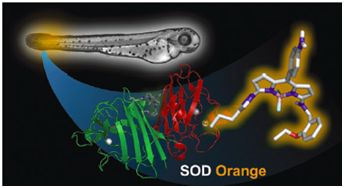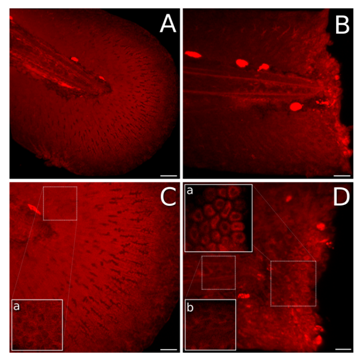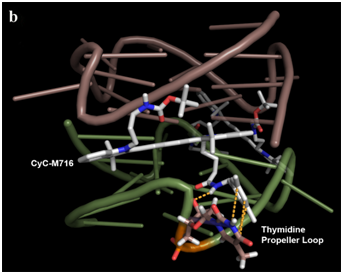
Fluorescent probes provide a tool to study proteins and DNA both in vivo and vitro by confocal microscopy and fluorescence techniques. Therefore, there is a strong impetus to develop probes to detect and identify these functional biomolecules in protein science and other biological processes.
Given this, collaborating with researchers from National University of Singapore and The University of Edinburgh (UK), a study team led by Dr. ZHANG Liyun in Institute of Technical Biology and Agriculture Engineering, Hefei Institutes of Physical Science, Chinese Academy of Sciences, developed novel small molecule fluorescent probes by diversity-oriented fluorescent library approach (DOFLA),which designed and synthesized a new class of BODIPY fluorogens with enhanced spectral properties by incorporating both rotational restriction and PeT-quenching groups.
In vitro, one of compounds (SODO) was identified as a highly selective fluorogenic probe for Cu/Zn SOD. SODO showed remarkable fluorescence emission enhancement (150-fold) only after binding to Cu/Zn SOD with very high selectivity over ROS-related enzymes and metabolites as well as the other SOD isoforms (i.e. Mn-SOD and Fe-SOD). The high selectivity of SODO enabled its use for imaging Cu/Zn SOD in vivo during the onset of an inflammatory response in a zebra fish tail fin injury model. SODO is the first fluorogenic probe for Cu/Zn SOD and represents a unique probe for the detection and in vivo imaging of Cu/Zn SOD during the progression of inflammatory disorders (Figure 1 and 2).
Inteins are auto-processing domains found in organisms from all domains of life. These proteins carry out a process known as protein splicing, which is a multi-step biochemical reaction comprised of both the cleavage and formation of peptide bonds. Inteins have been used as powerful proteins in protein engineering, labeling, purification and the control of protein function.
Despite great progress gained through research work, intein-based application still has its limitations caused by the difficulty in identifying functional intein. Graduate student LI Xin from the study team developed a fluorescent sensor – InR – with disaggregation-induced emission (DIE) characteristics for the label free detection of RecA inteins from Mycobacterium tuberculosis (Figure 3).
In addition, DNA, especially the aptamers, is another kind of target in research. Compared with the traditional double-helical structure of DNA, the formation, dismantlement and transformation between different topology structure of DNA G-quadruplexes(G4s) relates to regulation in some important physiological processes (such as apoptosis, cell proliferation, signal transduction and tumor formation, etc.).
Researchers constructed a 241-membered cyanine-based library by the combinatorial chemistry strategy. Combined with high-throughput screening, a novel fluorescent probe (CyC-M716) capable of identifying a subset of parallel G-quadruplexes with propeller loops stretching across three tetrad layers with high sensitivity and selectivity was developed (Figure 4). CyC-M716 represents a convenient tool for the sensitive differentiation of G4 structures and discovery of new ligands recognizing similar loop characteristics.
All these findings are available online in Chemical Communications entitled A highly selective fluorogenic probe for the detection and in vivo imaging of Cu/Zn superoxide dismutase, Development of a disaggregation-induced emission probe for the detection of RecA inteins from Mycobacterium tuberculosis and Development of fluorescent probes specific for parallel-stranded G-quadruplexes by a library approach. And this work was supported by the national “973” program and Natural Science Foundation of China.

Figure 1. SODO probe selectively and sensitively achieves the in vivo imaging and in vitro detection of Cu/Zn SOD. (Image by ZHANG Liyun)

Figure 2. In vivo imaging of Cu/Zn SOD in inflamed zebrafish during the onset of an inflammatory response tailfin injury model.
(Image by ZHANG Liyun)

Figure 3. Schematic Illustration of a DIE characteristics probe for RecA intein detection.(Image by ZHANG Liyun).

Figure 4. Molecular docking results of CyC-M716 binding to the J19. (Image by ZHANG Liyun)
Contact:
ZHANG Liyun
Institute of Technical Biology and Agriculture Engineering, Hefei Institutes of Physical Science, Chinese Academy of Sciences
Hefei, Anhui 230031, P. R. China.
Email: zly0605@ustc.edu.cn